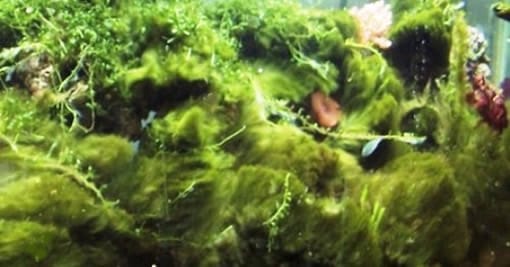Almost all new saltwater aquariums get green hair algae. This rapid growing algae is long and stringy, but can be removed by picking it at the base with your fingers. It typically grows on live rock and the aquarium glass.
It is normal to see a small green hair algae bloom one month after moving or starting a new saltwater fish aquarium, but growth should be limited after the addition of a clean-up crew or algae eating fish like a blenny or tang. For hair algae to grow, it requires light, nitrate, phosphate and carbon dioxide.
Green Hair Algae Causes
Green Hair Algae is caused by excess Dissolved Organic Carbons or DOC’s in the water. The most common reasons for having too many DOC’s include overfeeding, lack of filtration and the use of tap or well water for water changes or freshwater top off. Thankfully, Green Hair Algae is a fairly easy problem to fix when proper equipment and aquarium habits are combined with a clean-up crew.

Green Hair Algae Treatment
Steps to Reduce the Introduction of DOC’s. Use RODI Reverse Osmosis water to prevent the introduction of phosphates and nitrates. Typical tap and well water has a TDS, Total Dissolved Solids, of 250 to 500ppm. TDS is how much stuff is in your water. This includes copper, chlorine, phosphate, silicate, iron, zinc, lead and nitrate. After RO purification the typical TDS is between 5 and 10ppm, and after RO Deionization purification it is between 0 and 5ppm. As a result, algae has 25 to 50 times less nutrients that it can use to grow. Reduce the frequency of feedings and the amount of food fed to the aquarium. Stop feeding pellet and flake food. Instead, use high quality frozen or live foods as they have typically contain less phosphate and nitrate.
How to Increase the Export of DOC’s. Weekly 10-25% water changes with reverse osmosis water. Using tap or well water will only make the problem worse. Use a GFO (Granular Ferric Oxide) like Phosban to remove phosphate from the water. Increase filtration by adding a Protein Skimmer. Don’t skimp on this piece of equipment. Buy the best your budget can afford, so you don’t need to upgrade later. You can also search for other articles on this website about protein skimming.
Clean Up Crew & Refugium
Control Green Hair Algae. Manual removal with your hand or an algae scraper is the fastest and easiest way to reduce the Green Hair Algae in the reef aquarium. With your hand, remove as many large clumps as you can from the live rock and aquarium walls. It is not critical to completely remove the green hair algae, as any short patches will be eaten by the clean-up crew. Add a clean-up crew. Astrea and Turbo Snails are excellent Green Hair Algae grazers. These snails will eat algae off live rock and aquarium walls. About one Astrea Snail is recommended per two gallons of water and one Turbo Snail per five gallons of water. Other popular additions include a variety of hermit crabs, like Dwarf Blue Leg Hermit Crabs and Scarlet Reef Hermit Crabs. A sea urchin may also help eat green hair algae and other various types of algae. You may also introduce an algae eating fish, like a Lawnmower Blenny, recommended for aquariums 30 gallons or larger, or a Yellow Tang recommended for aquariums at least four feet long with plenty of rockwork where the fish can hide and a long stretch where the fish can swim. Most yellow tangs will quickly outgrow a 55 gallon aquarium, so be prepared to trade it in as the fish grows in size. Please note, these fish can grow to eight inches and have venomous spikes on each side of the tail. They will flare these spikes when scared or threatened, so caution should be taken when handling.
You can add a Refugium and macroalgae to compete with the Green Hair Algae for nutrients. Popular macroalgaes are Caulerpa and Chaetomorpha. Green Hair Algae will grow more rapidly in aquariums that allow fish food and waste to settle and decay. Increasing the water flow can help eliminate this problem. Reduce your aquarium’s photoperiod. If you run the lights for 12 to 16 hours per day, try cutting back to 8 to 10 hours per day. You may completely turn your fish tank lights off one day per week. This won’t hurt your corals, think of it as a cloudy or stormy day on the reef.
You may also need to replace your aquarium light bulbs if they are old. As the bulb ages, it begins to shift in color spectrum and intensity. This shift can encourage unwanted algae growth. Here are a few guidelines. Power Compact older than 6 months. Metal Halide older than 6 to 12 months depending on the bulb color. T5 older than one year. These can all cause a green hair algae bloom.
